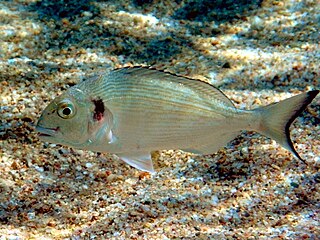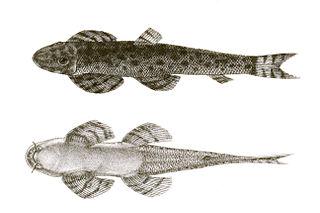
Catfish are a diverse group of ray-finned fish. Named for their prominent barbels, which resemble a cat's whiskers, catfish range in size and behavior from the three largest species alive, the Mekong giant catfish from Southeast Asia, the wels catfish of Eurasia, and the piraíba of South America, to detritivores, and even to a tiny parasitic species commonly called the candiru, Vandellia cirrhosa. Neither the armour-plated types nor the naked types have scales. Despite their name, not all catfish have prominent barbels or "whiskers". Members of the Siluriformes order are defined by features of the skull and swimbladder. Catfish are of considerable commercial importance; many of the larger species are farmed or fished for food. Many of the smaller species, particularly the genus Corydoras, are important in the aquarium hobby. Many catfish are nocturnal, but others are crepuscular or diurnal.

Herring are various species of forage fish, mostly belonging to the family of Clupeidae.

The ocean sunfish, also known as the common mola, is one of the largest bony fish in the world. It is the type species of the genus Mola, and one of five extant species in the family Molidae. It was once misidentified as the heaviest bony fish, which was actually a different and closely related species of sunfish, Mola alexandrini. Adults typically weigh between 247 and 1,000 kg. It is native to tropical and temperate waters around the world. It resembles a fish head without a tail, and its main body is flattened laterally. Sunfish can be as tall as they are long when their dorsal and ventral fins are extended.

George Albert Boulenger was a Belgian-British zoologist who described and gave scientific names to over 2,000 new animal species, chiefly fish, reptiles, and amphibians. Boulenger was also an active botanist during the last 30 years of his life, especially in the study of roses.

A fish is an aquatic, anamniotic, gill-bearing vertebrate animal with swimming fins and a hard skull, but lacking limbs with digits. Fish can be grouped into the more basal jawless fish and the more common jawed fish, the latter including all living cartilaginous and bony fish, as well as the extinct placoderms and acanthodians. Most fish are cold-blooded, their body temperature varying with the surrounding water, though some large active swimmers like white shark and tuna can hold a higher core temperature. Many fish can communicate acoustically with each other, such as during courtship displays. The study of fish is known as ichthyology.

Ventrifossa is a genus of rattails in the family Macrouridae.
Ventrifossa longibarbata is a species of rattail. This is a deep-water fish found at depths of up to 600 m. It is found in the waters off southern Japan and southeastern Taiwan.

The gilt-head bream, also known as the gilthead, gilt-head seabream or silver seabream, is a species of marine ray-finned fish belonging to the family Sparidae, the seabreams or porgies. This fish is found in the Eastern Atlantic and the Mediterranean. It is a highly esteemed food fish and an important species in aquaculture.
George Sprague Myers was an American ichthyologist who spent most of his career at Stanford University. He served as the editor of Stanford Ichthyological Bulletin as well as president of the American Society of Ichthyologists and Herpetologists. Myers was also head of the Division of Fishes at the United States National Museum, and held a position as an ichthyologist for the United States Fish and Wildlife Service. He was also an advisor in fisheries and ichthyology to the Brazilian Government.
Gentianella longibarbata is a species of flowering plant in the family Gentianaceae. It is endemic to Ecuador. Its natural habitat is subtropical or tropical high-altitude grassland.

An anchovy is a small, common forage fish of the family Engraulidae. Most species are found in marine waters, but several will enter brackish water, and some in South America are restricted to fresh water.

Balitora is a genus of ray-finned fishes in the family Balitoridae endemic to Asia.
Triplophysa longibarbata is a species of ray-finned fish in the genus Triplophysa. This cavefish is only known from Guizhou in China.
Sikukia is a genus of freshwater ray-finned fishes belonging to the family Cyprinidae, the family which includes the carps, barbs and related fishes. This fishes in this genus are found in eastern Asia.
Sikukia gudgeri is a species of freshwater ray-finned fish belonging to the family Cyprinidae, the family which includes the carps, barbs and related fishes. This species is found in the Mekong river system, The species is endemic to the Mekong basin, in Cambodia, Laos and Thailand, it is also known from the Tonle Sap system.

Sikukia stejnegeri is a species of freshwater ray-finned fish belonging to the family Cyprinidae, the family which includes the carps, barbs and related fishes. This species is found in Southeast Asia.

Cyprinae is a subfamily of largely freshwater ray-finned fishes, one of ten subfamilies belonging to the family Cyprinidae. This family comprises the carps, minnows, barbs and related fishes.

Scombriformes, also known as Pelagia and Pelagiaria, is an order of ray-finned fish within the clade Percomorpha. It contains 287 extant species in 16 families, most of which were previously classified under the suborders Scombroidei and Stromateoidei of the order Perciformes.

Paradiplozoon yunnanense is a species of monogenean of the family Diplozoidae. As in all species of this family, the bodies of the two hermaphroditic members of a couple are permanently fused for life.
Sikukia flavicaudata is a species of freshwater ray-finned fish belonging to the family Cyprinidae, the family which includes the carps, barbs and related fishes. This fish is found in the upper Mekong river system, in Yunnan, it has also been recored in Laos, and may be found in Myanmar and northern Thailand.













